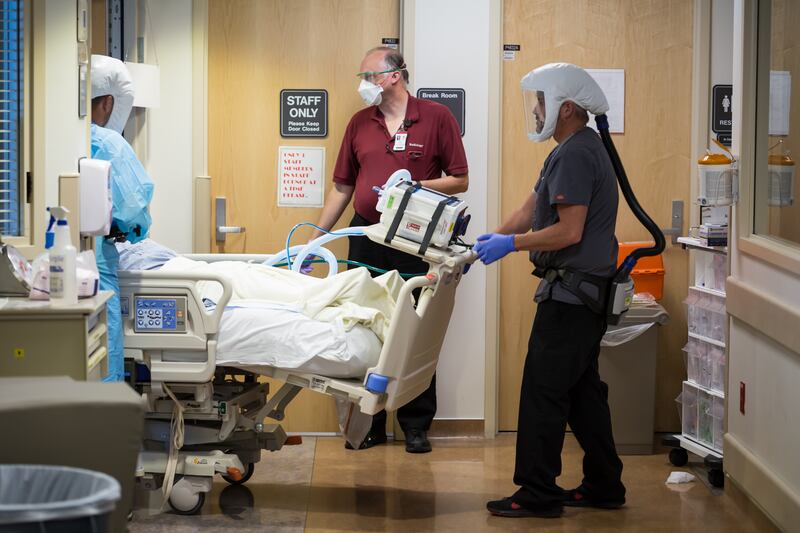SALT LAKE CITY — As Utah weather takes a frosty turn in the coming days, the state could become even more of a coronavirus hot spot.
Colder temperatures — lows on the Wasatch Front are expected to dip into the teens with the possibility of snow this weekend — will drive people indoors where COVID-19 can spread easier.
Dr. Deborah Birx, the White House Coronavirus Task Force coordinator, warned the nation’s governors in a conference call Friday of a broad surge in states where temperatures are cooling.
On Monday, the Utah Department of Health reported 1,196 new cases of COVID-19, bringing the state’s total number of infections resulting from the surging virus to 117,706 positive cases.
The rolling seven-day average number of daily positive tests is 1,647 per day. Meanwhile, the rolling seven-day average for percent of positive laboratory tests has now reached 19%, according to health department data.
The health department announced no new deaths Monday, leaving the total number of lives lost to COVID-19 in Utah at 614.
A total of 1,097,593 Utahns have been tested for COVID-19, including 8,744 more than Sunday.
There are 348 people currently hospitalized with COVID-19. Total hospitalizations from the beginning of the outbreak are 5,576, according to the health department.
Most of Utah’s 29 counties are designated as “high” transmission rate counties, according to the COVID-19 Transmission Index, the state’s newest plan advising public health guidance.
“We are in a point of our outbreak right now that we should really commit to our close contacts to only being people we are living with,” state epidemiologist Dr. Angela Dunn told the Deseret News over the weekend.
When health officials talk to people who contract COVID-19 about who they’ve been in contact with, it can stretch to 30 or 40 people and there is no way to get on top of the virus with that kind of exposure, Dunn said.
Two of the nation’s top health officials met with Utah health leaders Saturday to discuss strategies to curb the COVID-19 surge.
New testing approach
Record high numbers of new infections brought Birx and Dr. Robert Redfield, director of the Centers for Disease Control and Prevention, to University of Utah Hospital, where they heard about ongoing testing and mitigation efforts happening throughout Utah.
The two encouraged a new approach to testing at the university, where average case numbers have been lower than the surrounding Salt Lake County. Birx and Redfield said more frequent testing of key communities — students, health care workers, university staff and faculty — could help with tracing numbers back to the communities where they live.
Dr. Tom Miller, chief medical officer for hospitals and clinics for University of Utah Health, said that would mean moving away from testing people with symptoms to testing groups who might be carriers but asymptomatic.
“We now think that the spread of this illness is carried out by folks who have the illness or have the disease, have COVID, but don’t really have any symptoms. Then they go into places where people aren’t wearing masks and crowded situations and spread it,” he said Monday on KSL Newsradio’s “Live Mic.”
Newly developed “point-of-care” tests, which produce results in 10 to 15 minutes, could be administered regularly in public schools and universities, Miller said. How quickly the state could change its testing approach depends on the ability to obtain an adequate supply of the rapid tests to administer week after week, he said.
State health officials want to focus testing, both in frequency and quantity, on Utahns between the ages of 15 and 35, said Tom Hudachko, health department spokesman.
Universities would be places to do that because that’s where young adults not only congregate but where the virus can be spread.
Public universities in the state are holding a combination of in-person and virtual classes. Some, including the University of Utah and Utah State University, will go to online-only classes after the Thanksgiving break for the remainder of the semester.
People ages 15-24 account for 26% of COVID-19 cases in the state, while those age 25-44 make up 36% of cases, according to the health department.
Birx and Redfield also stressed the importance of face coverings, and asked state officials to enforce and advertise mask-wearing requirements. Miller said it would take 95% of the population to wear masks at school, church, family gathering and other indoor events to bring infection rates down.
“Masks are the medicine that we have right now,” Miller said. “If people will wear those masks until we get through this, they can take them off and throw them away.”
Thousands of young people who partied outside in Utah County on a balmy Halloween night — largely without masks — and who might be virus carriers will be looking for fun inside as the air chills and storms roll in.
Deputies responded to a large party on the west side of Utah Lake, south of Saratoga Springs near the Knolls about 10 p.m. Saturday. Utah County Sheriff’s Sgt. Spencer Cannon said “several thousand” people were in attendance, with the estimates from those who were there ranging from 2,000 to 10,000 people.
Cellphone videos of the event posted on social media show people, who appear to be high school or college age, packed together in a large group with no social distancing and very little mask wearing.
Both Gov. Gary Herbert and the Utah County Health Department on Sunday reacted to the party, again stressing that the social gatherings are still the main source of COVID-19 infections. Health officials encouraged those who attended the event to monitor themselves for symptoms and get tested if any of them show up.


